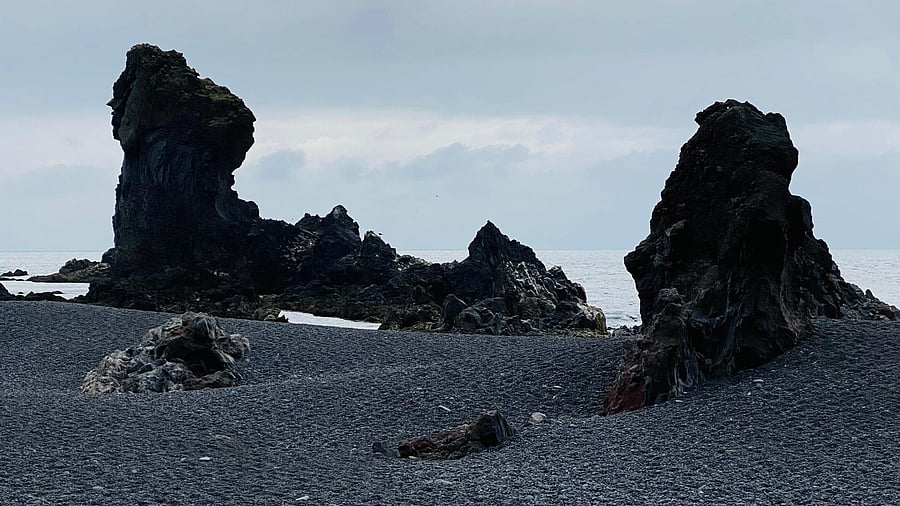
Songklettur, a large red rock on the shores of Djupalonssandur, is seen as a Church of the Elves.
Credit: Namratha Kallavi
Iceland is an island country in Europe known for its magical landscapes, which include snow-capped mountains, lava fields, hot springs, and active volcanoes. Situated between the North Atlantic and Arctic Oceans, Iceland is part of the Nordic group, a term used to refer to the countries of Northern Europe, including Finland, Denmark, Sweden, and Norway. Aptly named the “Land of Fire and Ice,” Iceland offers dramatic contrasts, from snow-covered peaks to volcanic sand shores and icy waters. The country is a popular destination for adventure travellers, particularly due to its harsh, windy winters, but it is equally enchanting during the summer months, from May to early September.
Reykjavik, the capital city, is home to one of Iceland’s international airports, which is well-connected to other European destinations. Additionally, cruises to Iceland depart from various Nordic cities. The capital offers a wide range of accommodations, including luxury hotels, Airbnbs, and hostels, all of which can be booked online. Unlike other Nordic countries, Iceland has limited public transportation. Visitors typically either rent cars to explore the country or join guided package tours, which are usually carried out in small groups of 10-15 people using minibuses. One of Iceland’s most popular tourist routes is the Golden Circle, which covers three major natural and historical attractions along a scenic route known as Route 1, starting and ending in Reykjavik.
Thingvellir National Park
The first stop is Thingvellir National Park, a UNESCO World Heritage Site. Situated along the Atlantic Ocean ridge, the park is home to many natural fissures caused by continental drift. The park boasts magnificent rock formations, cliffs, waterfalls, and a lake. One notable feature is Silfra, a fissure that separates the Eurasian and American tectonic plates. Visitors can dive into the crystal-clear waters of Silfra, touching both tectonic plates at once. Alternatively, you can walk through the valley that marks the border between the two continents. Historically, Thingvellir was the site of Iceland’s first parliament, established around 900 AD, where laws were made, disputes were settled, and criminals were tried.
Geysir
The next stop is Geysir, a geothermal area in the Haukadalur Valley. Geysers, hot-water springs caused by volcanic activity, are common throughout Iceland. Although the Geysir geyser itself is dormant, several active geysers in the area erupt every few minutes, sending steam and gas into the air. Iceland’s geothermal energy also plays a significant role in the country’s power generation. The hot spring water is supplied to homes, although it often has a pungent smell and is unsuitable for drinking. Bathing in natural hot springs is a popular tourist activity, with locations like The Blue Lagoon and The Sky Lagoon offering lukewarm waters ideal for relaxation.
Gullfoss Waterfall
The third stop is Gullfoss, also known as the Golden Waterfall. Iceland is home to many iconic waterfalls, and Gullfoss is among the most famous. Fed by the Langjokull glacier and the Hvita River, the water cascades down in two stages, creating a breathtaking sight that showcases the raw power of nature.
Snaefellsnes Peninsula
Iceland’s geological contrasts are perhaps best experienced in the west, particularly on the Snaefellsnes peninsula. Often called “Iceland in Miniature,” this region offers a diverse landscape of mountains, volcanic craters, glaciers, and rugged coastlines. One notable attraction is Kirkjufell, a cone-shaped mountain located about 180 km from Reykjavik on the Snaefellsnes Peninsula. Famous for its appearance in the TV show Game of Thrones, Kirkjufell, along with the nearby Kirkjufellsfoss waterfall, is one of the most photographed spots in Iceland.
A short 45 km away is Saxholl, a volcanic crater that erupted around 3,000 years ago. Hiking up the stairs to the top of the crater offers an awe-inspiring view of the barren, rocky lava fields surrounding it, with misty mountains and glaciers in the distance. You can even see the mighty Atlantic Ocean on the horizon.
Snaefellsjokull National Park
Further along, you’ll find Snaefellsjokull National Park, home to Djupalonssandur beach, with its black volcanic sand. The beach is dotted with large rocks that were once used by fishermen to test their strength. If the skies are clear, you can see the towering Snaefellsjokull glacier in the distance. The glacier sits atop a dormant volcano, and the mountain’s peak is a sight to behold.
Another intriguing feature of the park is Songklettur, a massive lava rock formation believed to be the “Church of the Elves” in Icelandic folklore. Iceland is rich in tales of mythical creatures like elves, trolls, and giants, and many rock formations like Songklettur are revered in these stories. Tourists are encouraged to show respect for these sites, as climbing on the rocks is prohibited.